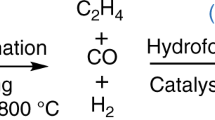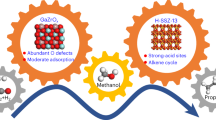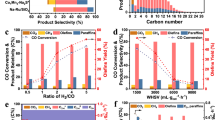Abstract
Although considerable progress has been made in carbon dioxide (CO2) hydrogenation to various C1 chemicals, it is still a great challenge to synthesize value-added products with two or more carbons, such as gasoline, directly from CO2 because of the extreme inertness of CO2 and a high C–C coupling barrier. Here we present a bifunctional catalyst composed of reducible indium oxides (In2O3) and zeolites that yields a high selectivity to gasoline-range hydrocarbons (78.6%) with a very low methane selectivity (1%). The oxygen vacancies on the In2O3 surfaces activate CO2 and hydrogen to form methanol, and C−C coupling subsequently occurs inside zeolite pores to produce gasoline-range hydrocarbons with a high octane number. The proximity of these two components plays a crucial role in suppressing the undesired reverse water gas shift reaction and giving a high selectivity for gasoline-range hydrocarbons. Moreover, the pellet catalyst exhibits a much better performance during an industry-relevant test, which suggests promising prospects for industrial applications.
This is a preview of subscription content, access via your institution
Access options
Access Nature and 54 other Nature Portfolio journals
Get Nature+, our best-value online-access subscription
$29.99 / 30 days
cancel any time
Subscribe to this journal
Receive 12 print issues and online access
$259.00 per year
only $21.58 per issue
Buy this article
- Purchase on Springer Link
- Instant access to full article PDF
Prices may be subject to local taxes which are calculated during checkout





Similar content being viewed by others
References
Kothandaraman, J. et al. Amine-free reversible hydrogen storage in formate salts catalyzed by ruthenium pincer complex without PH control or solvent change. ChemSusChem 8, 1442–1451 (2015).
Aresta, M., Dibenedetto, A. & Angelini, A. Catalysis for the valorization of exhaust carbon: from CO2 to chemicals, materials, and fuels. Technological use of CO2 . Chem. Rev. 114, 1709–1742 (2014).
Li, C. W., Ciston, J. & Kanan, M. W. Electroreduction of carbon monoxide to liquid fuel on oxide-derived nanocrystalline copper. Nature 508, 504–507 (2014).
Li, C.-S. et al. High-performance hybrid oxide catalyst of manganese and cobalt for low-pressure methanol synthesis. Nat. Commun. 6, 6538 (2015).
Graciani, J. et al. Highly active copper–ceria and copper–ceria–titania catalysts for methanol synthesis from CO2 . Science 345, 546–550 (2014).
Scirè, S., Crisafulli, C., Maggiore, R., Minicò, S. & Galvagno, S. Influence of the support on CO2 methanation over Ru catalysts: an FT-IR study. Catal. Lett. 51, 41–45 (1998).
Moret, S., Dyson, P. J. & Laurenczy, G. Direct synthesis of formic acid from carbon dioxide by hydrogenation in acidic media. Nat. Commun. 5, 4017 (2014).
Studt, F. et al. Discovery of a Ni–Ga catalyst for carbon dioxide reduction to methanol. Nat. Chem. 6, 320–324 (2014).
Gao, S. et al. Partially oxidized atomic cobalt layers for carbon dioxide electroreduction to liquid fuel. Nature 529, 68–71 (2016).
Yin, Z. et al. Highly selective palladium–copper bimetallic electrocatalysts for the electrochemical reduction of CO2 to CO. Nano Energy 27, 35–43 (2016).
Dixneuf, P. H. Bifunctional catalysis: a bridge from CO2 to methanol. Nat. Chem. 3, 578–579 (2011).
Sakakura, T., Choi, J.-C. & Yasuda, H. Transformation of carbon dioxide. Chem. Rev. 107, 2365–2387 (2007).
Montoya, J. H., Peterson, A. A. & Nørskov, J. K. Insights into C–C coupling in CO2 electroreduction on copper electrodes. ChemCatChem 5, 737–742 (2013).
Aresta, M., Dibenedetto, A. & Angelini, A. The changing paradigm in CO2 utilization. J. CO2 Util. 3–4, 65–73 (2013).
Benson, E. E., Kubiak, C. P., Sathrum, A. J. & Smieja, J. M. Electrocatalytic and homogeneous approaches to conversion of CO2 to liquid fuels. Chem. Soc. Rev. 38, 89–99 (2009).
Rodemerck, U. et al. Catalyst development for CO2 hydrogenation to fuels. ChemCatChem 5, 1948–1955 (2013).
Dorner, R. W., Hardy, D. R., Williams, F. W. & Willauer, H. D. Heterogeneous catalytic CO2 conversion to value-added hydrocarbons. Energy Environ. Sci. 3, 884–890 (2010).
Ye, J. Y., Liu, C. J., Mei, D. H. & Ge, Q. F. Active oxygen vacancy site for methanol synthesis from CO2 hydrogenation on In2O3(110): a DFT study. ACS Catal. 3, 1296–1306 (2013).
Martin, O. et al. Indium oxide as a superior catalyst for methanol synthesis by CO2 hydrogenation. Angew. Chem. Int. Ed. 55, 6261–6265 (2016).
Kim, J., Choi, M. & Ryoo, R. Effect of mesoporosity against the deactivation of MFI zeolite catalyst during the methanol-to-hydrocarbon conversion process. J. Catal. 269, 219–228 (2010).
Liu, Z. Y. et al. Solvent-free synthesis of c-axis oriented ZSM-5 crystals with enhanced methanol to gasoline catalytic activity. ChemCatChem 8, 3317–3322 (2016).
Olsbye, U. et al. Conversion of methanol to hydrocarbons: how zeolite cavity and pore size controls product selectivity. Angew. Chem. Int. Ed. 51, 5810–5831 (2012).
Olsbye, U., Bjørgen, M., Svelle, S., Lillerud, K.-P. & Kolboe, S. Mechanistic insight into the methanol-to-hydrocarbons reaction. Catal. Today 106, 108–111 (2005).
Van Speybroeck, V. et al. Advances in theory and their application within the field of zeolite chemistry. Chem. Soc. Rev. 44, 7044–7111 (2015).
Khodakov, A. Y., Chu, W. & Fongarland, P. Advances in the development of novel cobalt Fischer–Tropsch catalysts for synthesis of long-chain hydrocarbons and clean fuels. Chem. Rev. 107, 1692–1744 (2007).
Van der Laan, G. P. & & Beenackers, A. A. C. M. Kinetics and selectivity of the Fischer–Tropsch synthesis: a literature review. Catal. Rev. 41, 255–318 (1999).
Xiang, Y. Z. & Kruse, N. Tuning the catalytic CO hydrogenation to straight- and long-chain aldehydes/alcohols and olefins/paraffins. Nat. Commun. 7, 13058 (2016).
Behrens, M. et al. Performance improvement of nanocatalysts by promoter-induced defects in the support material: methanol synthesis over Cu/ZnO:Al. J. Am. Chem. Soc. 135, 6061–6068 (2013).
Gao, P. et al. Influence of Zr on the performance of Cu/Zn/Al/Zr catalysts via hydrotalcite-like precursors for CO2 hydrogenation to methanol. J. Catal. 298, 51–60 (2013).
Fujiwara, M., Kieffer, R., Ando, H. & Souma, Y. Development of composite catalysts made of Cu–Zn–Cr oxide zeolite for the hydrogenation of carbon-dioxide. Appl. Catal. A 121, 113–124 (1995).
Jeon, J.-K., Jeong, K.-E., Park, Y.-K. & Ihm, S.-K. Selective synthesis of C3–C4 hydrocarbons through carbon-dioxide hydrogenation on hybrid catalysts composed of a methanol synthesis catalyst and SAPO. Appl. Catal. A 124, 91–106 (1995).
Fujiwara, M., Satake, T., Shiokawa, K. & Sakurai, H. CO2 hydrogenation for C2+ hydrocarbon synthesis over composite catalyst using surface modified HB zeolite. Appl. Catal. B 179, 37–43 (2015).
Inui, T., Kitagawa, K., Takeguchi, T., Hagiwara, T. & Makino, Y. Hydrogenation of carbon-dioxide to C1–C7 hydrocarbons via methanol on composite catalysts. Appl. Catal. A 94, 31–44 (1993).
Martin, O. et al. Zinc-rich copper catalysts promoted by gold for methanol synthesis. ACS Catal. 5, 5607–5616 (2015).
Jiao, F. et al. Selective conversion of syngas to light olefins. Science 351, 1065–1068 (2016).
Cheng, K. et al. Direct and highly selective conversion of synthesis gas into lower olefins: design of a bifunctional catalyst combining methanol synthesis and carbon–carbon coupling. Angew. Chem. Int. Ed. 55, 4725–4728 (2016).
Zecevic, J., Vanbutsele, G., de Jong, K. P. & Martens, J. A. Nanoscale intimacy in bifunctional catalysts for selective conversion of hydrocarbons. Nature 528, 245–254 (2015).
Fu, X. Z., Clark, L. A., Zeltner, W. A. & Anderson, M. A. Effects of reaction temperature and water vapor content on the heterogeneous photocatalytic oxidation of ethylene. J. Photochem. Photobiol. A 97, 181–186 (1996).
Lloyd, L. Handbook of Industrial Catalysts (Springer, 2007).
Subramani, V. & Gangwal, S. K. A review of recent literature to search for an efficient catalytic process for the conversion of syngas to ethanol. Energy Fuels 22, 814–839 (2008).
Acknowledgements
This work was supported by the National Natural Science Foundation of China (21503260, 21573271, 91545112 and 11227902), the Shanghai Municipal Science and Technology Commission, China (14DZ1207602, 16DZ1206900 and 15DZ1170500), the Ministry of Science and Technology of China (2016YFA0202802) and the Chinese Academy of Sciences (QYZDB-SSW-SLH035). We thank Z. Liu and Y. Han for the assistance with in situ NAP–XPS, located at the State Key Laboratory of Functional Materials for Informatics, Shanghai Institute of Microsystem and Information Technology, Chinese Academy of Sciences.
Author information
Authors and Affiliations
Contributions
P.G., L.Z. and Y.S. conceived the project, analysed the data and wrote the paper. P.G., S.L. and W.W. drafted the manuscript. P.G. and S.D. prepared the samples. S.L. performed DFT calculations. Z.L. and H.W. studied the effect of the integration manner. X.B., M.Q. and C.Y. performed the catalytic evaluation. S.D., Z.L., X.B. and J.C. characterized the samples. All the authors discussed the results and commented on the manuscript.
Corresponding authors
Ethics declarations
Competing interests
The authors declare no competing financial interests.
Supplementary information
Supplementary information
Supplementary information (PDF 2043 kb)
Rights and permissions
About this article
Cite this article
Gao, P., Li, S., Bu, X. et al. Direct conversion of CO2 into liquid fuels with high selectivity over a bifunctional catalyst. Nature Chem 9, 1019–1024 (2017). https://doi.org/10.1038/nchem.2794
Received:
Accepted:
Published:
Issue Date:
DOI: https://doi.org/10.1038/nchem.2794
This article is cited by
-
Upgrading CO2 to sustainable aromatics via perovskite-mediated tandem catalysis
Nature Communications (2024)
-
Tandem reactors and reactions for CO2 conversion
Nature Chemical Engineering (2024)
-
Zeolite-confined Fe-site Catalysts for the Hydrogenation of CO2 to Produce High-value Chemicals
Chemical Research in Chinese Universities (2024)
-
A Prospective on Energy and Environment Applications of High Entropy Alloys
Transactions of the Indian National Academy of Engineering (2024)
-
Cu-Based Materials for Enhanced C2+ Product Selectivity in Photo-/Electro-Catalytic CO2 Reduction: Challenges and Prospects
Nano-Micro Letters (2024)



